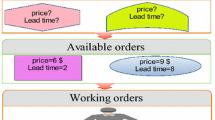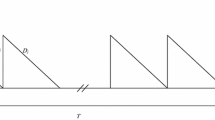Abstract
Optimal queuing system design includes deciding about some variables such as location, capacity, price, and delivery time. In order to develop an optimized system, it is essential to solve the optimization problem for all the decision variables simultaneously. In this paper, a make-to-order system is considered. In this system, some facilities are developed in different points. According to the make-to-order system definition, these facilities keep no inventory from final product. Orders are received from customers and the requested products are assembled. Due to existence of some differences among customers, they are divided into two distinct categories including express and regular customers. Each category has purchasing and upgrading demand. Upgrading demand is related to the used products that are referred to the facilities by reverse logistics for upgrade. Profit is maximized through attracting these two types of demand from different demand points. Utilizing market segmentation, different prices can be offered to each category. Difference in price is due to difference in delivery time. It means maximum guaranteed time to deliver the product. This obligation raises customer satisfaction. But lower delivery time causes increase in price and lower power in competition. Increase is price is due to designing a queue with higher capacity. In this problem, location of facilities should be selected among some potential points. There are several competitors in each potential location. Each facility is modeled as a queuing system. In these systems, decision variables are location, capacity, price, and delivery time. Finally, the optimization problem is solved by the genetic algorithm and the optimized value for each variable is gained. Facilities with these variables will have the maximum profit.




Similar content being viewed by others
References
Aboolian, R., O. Berman, and Z. Drezner. 2008. Location and allocation of service units on a congested network. IIE Transactions 40 (4): 422–433.
Aboolian, R., O. Berman, and Z. Drezner. 2009. The multiple server center location problem. Annals of Operations Research 167 (1): 337–352.
Abouee-Mehrizi, H., S. Babri, O. Berman, and H. Shavandi. 2011. Optimizing capacity, pricing and location decisions on a congested network with balking. Mathematical Methods of Operations Research 74 (2): 233–255. https://doi.org/10.1007/s00186-011-0361-6.
Amiri, A. 1997. Solution procedures for the service system design problem. Computers & Operations Research 24 (1): 49–61.
Baron, O., O. Berman, and D. Krass. 2008. Facility location with stochastic demand and constraints on waiting time. Manufacturing & Service Operations Management 10 (3): 484–505.
Boronico, J., and A. Panayides. 2001. The joint determination of price, quality, and capacity: An application to supermarket operations. Journal of Applied Mathematics & Decision Sciences 5 (1): 133–150.
Dasci, A., and G. Laporte. 2004. Location and pricing decisions of a multistore monopoly in a spatial market. Journal of Regional Science 44 (3): 489–515.
Dobson, G., and E. Stavrulaki. 2007. Simultaneous price, location, and capacity decisions on a line oftime-sensitive customers. Naval Research Logistics 54 (1): 1–10.
Drezner, T., and Z. Drezner. 2011. The gravity multiple server location problem. Computers & Operations Research 38 (3): 694–701.
Hanjoul, P., P. Hansen, D. Peeters, and J. Thisse. 1990. Uncapacitated plant location under alternative spatial policies. Management Science 36 (1): 41–57.
Hotelling, H. 1929. Stability in competition. Economic Journal 39: 41–57.
Marianov, V., and D. Serra. 1998. Probabilistic maximal covering location–allocation models for congested systems. Journal of Regional Science 38 (3): 401–424.
Marianov, V., M. Rios, and M.J. Icaza. 2008. Facility location for market capture when users rank facilities by shorter travel and waiting times. European Journal of Operational Research 191 (1): 32–44.
Mcfadden, D. 1974. The measurement of urban travel demand. Journal of Public Economics 3 (4): 303–328.
Pangburn, M., and E. Stavrulaki. 2008. Capacity and price setting for dispersed, time-Sensitive customer segments. European Journal of Operational Research 184 (3): 1100–1121.
Seifbarghy, M., R. Rabieian, and F. Karimi. 2011. Locating service centers optimizing customers’ perspective criteria. The International Journal of Advanced Manufacturing Technology 54 (5–8): 811–819.
Teimoury, E., M. Modarres, A. KazeruniMonfared, and M. Fathi. 2011. Price, delivery time, and capacity decisions in an M/M/1 make-to-order/service system with segmented market’. International journal of advance manufacturing technology. 57 (1–4): 235–244. https://doi.org/10.1007/s00170-011-3261-2.
Wang, Q., R. Batta, and C.M. Rump. 2002. Algorithms for a facility location problem with stochastic customer demand and immobile servers. Annals of Operations Research 111: 17–34.
Zhang, C., J. Ning, S. Lu, D. Ouyang, and T. Ding. 2009. A novel hybrid differential evolution and particle swarm optimization algorithm for unconstrained optimization. Operations Research Letters 37 (2): 117–122.
Author information
Authors and Affiliations
Corresponding author
Additional information
Publisher's Note
Springer Nature remains neutral with regard to jurisdictional claims in published maps and institutional affiliations.
Rights and permissions
About this article
Cite this article
Teimoury, E., Modarres, M. & Neishaboori, M. Cost-based differential pricing for a make-to-order production system in a competitive segmented market. J Revenue Pricing Manag 19, 266–275 (2020). https://doi.org/10.1057/s41272-019-00211-8
Received:
Accepted:
Published:
Issue Date:
DOI: https://doi.org/10.1057/s41272-019-00211-8




